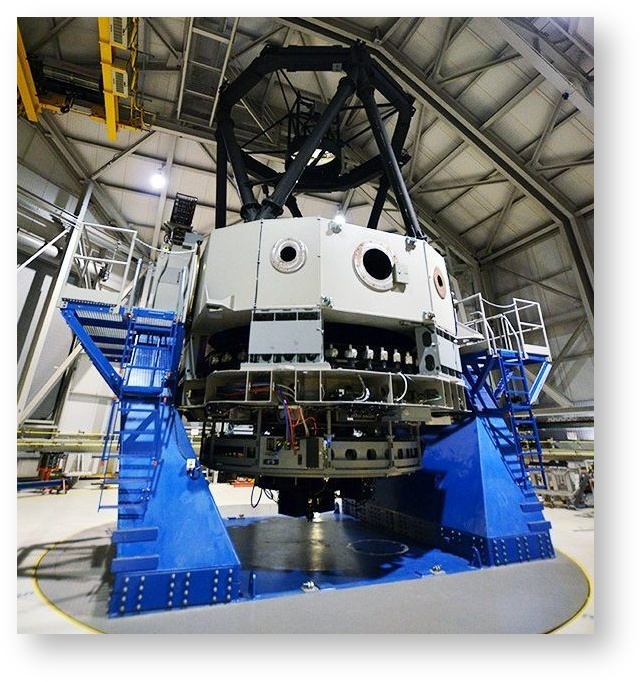- Created by Timothy Ellsworth-Bowers, last modified on Apr 14, 2023
Facility Instruments: Visitor / PI Instruments: High-Res Spectrograph (EXPRES) User Manuals:

Mount Performance, Dome Info, & Zones of Avoidance
Active Optics System / Wavefront Sensing
LDT (formerly DCT) Selected Technical Publications & References (full papers)
Lowell Discovery Telescope
Mount:
The telescope mount is an elevation over azimuth mount, which rotates freely within the enclosure. It was designed and fabricated by General Dynamics SATCOM. Mechanically, the system is very similar to the VISTA and SOAR telescopes. The telescopes operational pointing limits are between Elevation of +5º and 89.4º. In Azimuth, it can track 270º either direction from South before it must reset.
Optics:
Primary Mirror: The mirror was cast by Corning Glassworks, and figured and polished by the University of Arizona Optical Sciences Center.
Diameter: 4.3 m (aperture stop opening 4.25 m)
Focal ratio: f/1.9
Thickness: 4 inches
Composition: Ultra-low expansion (ULE) glass, thin meniscus.
Supported:
laterally by 36 pneumatic actuators mounted in a Schwesinger style configuration to minimize induced aberration.
axially by 120 electromechanical actuators
Secondary Mirror: The mirror was provided by Momentive Performance Materials, lightweighted at Mindrum Precision and figured and polished by L-3 Integrated Optical Systems – Brashear.
Diameter: 1.4 m
- Composition:GE124 fused quartz, lightweighted honeycomb
Supported by:
three axial definers
central radial defining hub
- tangent defining strap
During operations, the secondary is floated using modest partial vacuum (approximately -0.25 psig). The mirror is lifted to rest against the 3 axial defining points.
- The lampshade baffle around the secondary has a diameter of 1.52 m (central obscuration)
Ritchey–Chrétien (RC) Focus:
Effective focal ratio: f/6.1
Through port corrected (flattened) FOV: 30' diameter
Plate Scale: 8" / mm at the through port focal plane (which includes the corrector lens).
- Effective telescope aperture in RC configuration: 12.37 m2
Instrument Ports:
The RC focus has an instrument rotator capable of moving 270º in either direction from its zero point. The rotator carries the RC Instrument Cube which supports the simultaneous mounting of up to 5 different instruments. The rotator can carry up to 3,300 lbs. The cube accounts for 1,200 lbs, leaving 2,100 lbs for instrumentation. Because of the design of the telescope mount, the available volume at the Cassegrain focus is very limited and the cube and instruments must fit within that volume.
Through Port: Sits behind the 2-element field-flattening corrector lens. The current through port FoV is 12.3 x 12.3 arcminutes.
2 Large folded (side) ports fed by moveable fold mirrors. Usable FoV roughly 3 to 5 arcminutes. These ports are picked off above the corrector lens.
2 Small folded (side) ports fed by moveable fold mirror / dichroic. Usable FoV roughly 3 to 5 arcminutes. These ports are also picked off above the corrector lens.
- The telescope is also outfitted with two Nasmyth ports and 6 bent Cassegrain ports. These have not been instrumented yet. To do so will require the development and installation of a tertiary mirror and instrument rotators on the ports.
- No labels